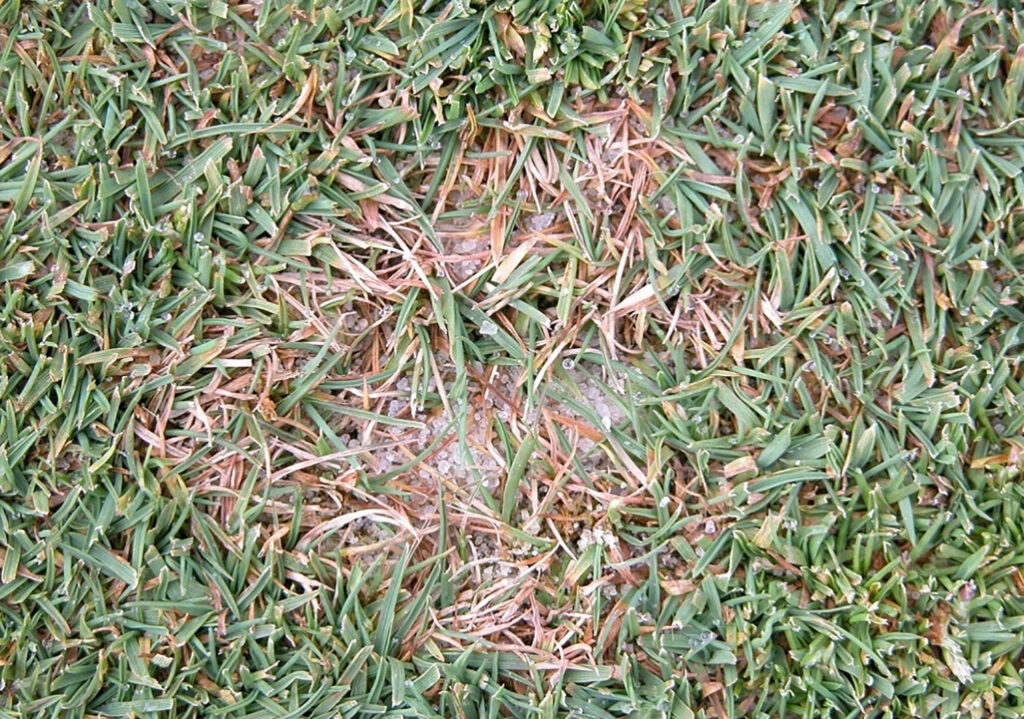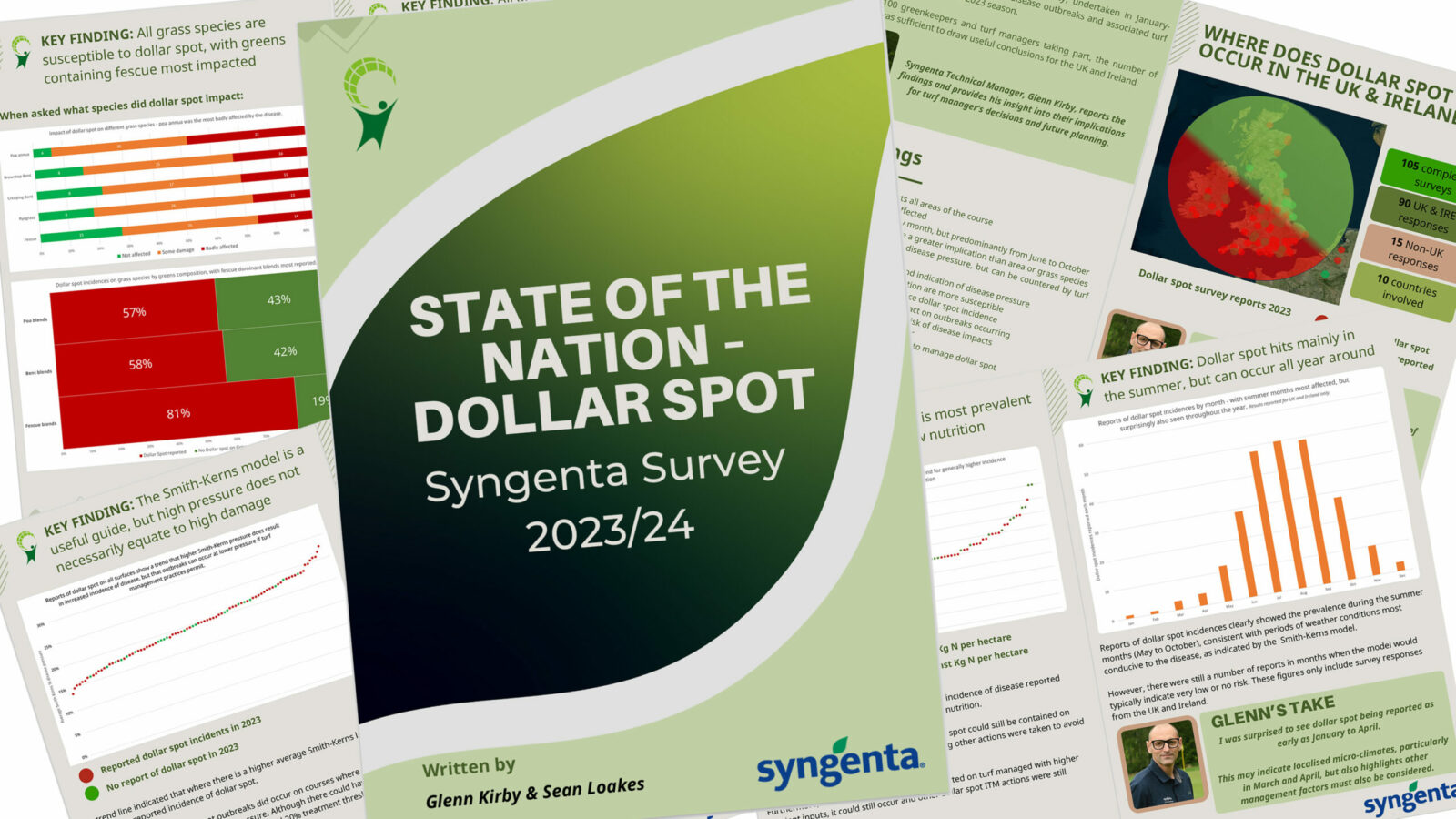Syngenta has published the findings of the Dollar Spot State of the Nation Survey 2024. Key findings of the report highlight the role for Integrated Turf Management actions to reduce disease outbreaks, including nutrition, rolling, moisture management and fungicide timings.
Assessing responses from over 100 golf course managers, Syngenta Technical Managers, Glenn Kirby and Sean Loakes, reported the scale of issues with dollar spot have become far more widespread – affecting all areas of the course and for a far extended part of the season.
“Dollar spot had typically been attributed as a summer disease, but the reports have shown it can occur throughout the year, with significant numbers of outbreaks reported from March right through to October,” commented Sean Loakes.

“Furthermore, while it has frequently been associated with less intensively managed tees, fairways and approaches, the report highlighted that greens were actually the most frequently affected surfaces.”
He added that all grass species would appear to be affected, with the management actions on turf a more influential factor of disease outbreak, over the species composition of the sward. Dollar spot outbreaks were reported on 81% of instances of fescue dominant greens, compared to 58% of bent blends and 57% poa dominant surfaces.
Linking the postcode of survey responses to local records of Smith-Kerns pressure, of weather conditions that would be associated with dollar spot outbreaks, revealed that high pressure would indicate more disease.
“However, it is not a clear-cut correlation,” said Sean. “Some courses under prolonged high pressure reported no dollar spot incidences, which indicates that the disease can be effectively managed by other turf management actions.
“Equally, some courses with relatively low weather related pressure did report dollar spot infections. This has highlighted that the Smith-Kerns model is a useful guide for risk, but that the numbers must be interpreted along with all other actions in making decisions.”

For effective ITM strategies, frequent rolling, maintaining higher soil moisture content and providing higher levels of nutrition were all associated with lower levels of dollar spot being reported, Sean added.
“The survey responses showed a clear trend of a higher incidence of disease reported where turf was being managed at lower rates of nutrition.
“However, it was not exclusively so, indicating that dollar spot could still be contained on lower nutrient management strategies, providing other ITM actions were taken to avoid outbreaks,” he advised.
“Furthermore, while fewer outbreaks were reported on turf managed with higher nutrient inputs, it could still occur if turf management practices and conditions were conducive to disease.”
Responses to the Dollar Spot State of the Nation Survey also showed the link between management to target lower levels of soil volumetric moisture content (VMC) and the reported incidence of dollar spot.
Surfaces targeted to manage VMC below 15% reported the highest levels of infection outbreaks, at over 70% of instances. When responses for surfaces managed at a higher target VMC of 21 to 25% were assessed, over 60% of courses reported no outbreaks dollar spot.
“The survey responses showed a clear pattern that the greater use of turf iron for rolling surfaces resulted in a reduced incidence of dollar spot reports,” Sean pointed out.
“On courses where greens were never rolled dollar spot was reported in 75% of cases, with a trend declining to 50% of courses rolling surface five times a week. Most courses (61%) were reported to be rolling surfaces two or three times a week.”
For courses that were rolling almost daily, there was no incidence of dollar spot reported. However, this was a very small proportion of the survey responses (3%).
The survey identified no link between organic matter levels and dollar spot outbreaks, however there was some indication that lower cutting height could be associated with reduced levels of infection. “This is an element of the ITM strategy requires further investigation,” he suggested.
Analysis of the Dollar Spot State of the Nation Survey indicate that where greenkeepers are managing to promote fescue dominant surfaces, they are lowering the target moisture levels, reducing the nitrogen applied and raising the height of cut, compared to predominantly poa and bent greens.
Greens containing fescue receive, on average, 40% less nitrogen compered to poa or bent greens. Fescue greens are also managed at a target VMC 4-5% lower and with a height of cut at an average 3.9mm, which is 0.4-0.5mm higher than poa or bent greens.
“From the findings of the report these management practices may also be playing into the hands of dollar spot.
“Whilst the feeling is that fescue species are slightly more tolerant to dollar spot, the management practices needed to maintain them can lead to fescue dominant surfaces being more vulnerable to the disease,” he warned.
The report identified that most greenkeepers – nearly 70% – have used fungicides as part of their strategy to manage dollar spot.
“While in some situations managers may consider that dollar spot doesn’t warrant fungicidal control on all areas of the course, as the climate changes we need to consider how we keep damage at an acceptable level,” added Sean.
“New fungicide technology, good disease modelling to help improve timings and good application techniques will help turf managers get the best out of them as part of their Integrated Turf Management strategy.”
Responses to the survey have provided guidance on a number of actions that turf managers could consider to reduce risks and minimise impact of this increasingly challenging disease.
Sean’s Top Tips to reduce dollar spot pressure and better manage disease:
- Adequate nutrition
- Maintain moisture levels
- Regular rolling
- Lower cutting heights
- Monitor weather conditions conducive to disease
- Timely and accurate fungicide application
- Year-round management
“A better understanding of the implications of certain management practices on the risk of dollar spot, could help to instigate counter measures to reduce pressure in the future,” he concluded.
Following on from the dollar spot survey, a new Microdochium Patch State of the Nation Survey will seek to identify and share experiences of management practices to help all turf managers effectively tackle the most widespread turf disease. Complete the survey here.
The full Dollar Spot State of the Nation Survey 2024report is available to download from the Syngenta Turf & Landscape website.

